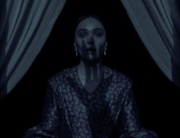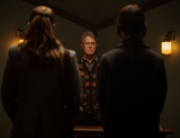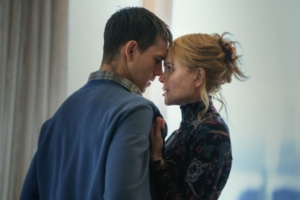
Among the more prominent trends in recently is the mystical art-house film. Like any blanket categorization, its uses are limited, but broadly speaking, it is a movie that incorporates fairytales, horror, various other genre elements, or just plain weirdness, while simultaneously wearing its more high-brow aspirations on its sleeve. They include, but are not limited to, The Babadook, A Girl Walks Home Alone at Night, The Witch, Get Out, Atlantics, and The Green Knight. Some of them are excellent films; others I don’t think will age well. At this point, it is so much of a trend that it is no surprise when there is a new one. Many are released by A24, as is Lamb, the debut film by Valdimar Johannsson.
As a variation on the classic fairytale of a childless couple, Lamb is more traditional than many of its forebears from A24. Maria (Noomi Rapace) and Ingvar (Hilmir Snaer Guonason) live alone on an enormous farm in a mountainous, isolated Icelandic wilderness. They tend to a flock of sheep, they work the land, and both seem incredibly sad, though it is unclear what exactly they have suffered. However, the film begins not with them but with their sheep, huddling together on a windy night, while outside we hear a forbidding growl. One sheep, spent and exhausted, stumbles toward the rest of the flock and collapses before them. Not a single sheep rushes to her aid—clearly, they are frightened.
Soon after, Maria and Ingvar are helping birth lambs, and they make a strange discovery. It is not much of a spoiler at all to say the aforementioned sheep gives birth to a lamb with the body of a girl. Maria, when she sees this creature, is immediately transfixed and pulls her close. She feels that this child is hers to raise so quickly that we don’t even witness her make the decision. She sets up a bassinet, she gets the lamb clothes, and she names her Ada. Ingvar gradually gets on board. The rest of the movie concerns their attempt to raise Ada as their child while contending with the various threats to their idyllic existence. These include Ada’s actual mother (the sheep), Ingvar’s brother, Petur (Bjorn Hlynur Haraldsson), who comes to stay with them, and the mysterious, unspecified call of nature.
I initially resisted the movie. I approached it with some fatigue with the mystical art-house film. When it began, something felt too artificial. This gorgeous, windswept landscape, conveniently far away from the rest of the world and its complications; the cold beauty of its stars; the couple’s gorgeous house: all of this felt too calculated to be truly involving.
Yet one of the more compelling themes here is the abuse of nature, how humans will do so wantonly to satisfy their emotional needs in spite of even the most obvious warnings. Therefore, it makes perfect sense that Maria and Ingvar’s lives and their surroundings are almost artificially beautiful. They are, in fact, as unreal as their deluded dreams. As I gradually realized this, the film won me over.
Though there is always an undercurrent of danger, there are only a few bursts of violence. Mostly, the action centers on the domestic dynamics, though the angry, ambiguous presence of nature lurks in the background. It is through this quiet, accumulation of unsettling details and development of mood that Lamb derives its power.
Most of all, Ada is a pleasure to watch. Her face is animated with expression that gives her presence real solidity and nuance, and it is amusing and unsettling to watch her perform everyday tasks, whether it be taking a bath with her mother or bringing breakfast to the table for her father. Through her watchfulness, she evolves as clearly as the others.
Lamb may still feel a little too arch, yet it is an involving film that acquires some genuine power as it gains momentum. It would make a good double feature with Jan Svankmajer’s Little Otik (2000), another fairy tale about a childless couple. While I ultimately prefer the unhinged wildness of Svankmajer’s film, Lamb appears (for now, at least) to transcend the trend it so neatly falls into, and to stand very well on its own feet.
















Leave A Comment